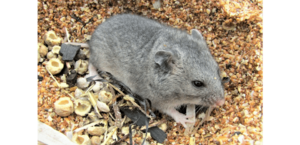Grey dwarf hamster facts for kids
Quick facts for kids Grey dwarf hamster |
|
|---|---|
 |
|
| Conservation status | |
| Scientific classification | |
| Genus: |
Nothocricetulus
|
| Species: |
migratorius
|
| Synonyms | |
|
Cricetulus migratorius |
|
The grey dwarf hamster is a small, furry animal. It is also known as the grey hamster or migratory hamster. Its scientific name is Nothocricetulus migratorius. This hamster lives across a huge area. You can find it from Eastern Europe all the way to China. It has soft grey fur. These hamsters are usually about 8.5 to 12 centimeters (3.3 to 4.7 inches) long. Experts say it is a "least concern" animal. This means it is not currently in danger.
Contents
About the Grey Dwarf Hamster
The grey dwarf hamster was once thought to belong to a different group of hamsters. That group was called Cricetulus. However, scientists have recently decided it is special enough. So, they gave it its very own group, or genus. This new group is called Nothocricetulus.
What Does It Look Like?
The grey dwarf hamster is quite small. Its head and body together measure between 8.5 and 12 centimeters (3.3 to 4.7 inches). Its tail is about one-third as long as its body. It is covered in soft fur. These hamsters usually weigh between 31 and 58 grams (1.1 to 2 ounces).
Their fur is a sandy brownish-grey color on top. Their bellies are whitish. The white hairs often have grey bases. They have large ears. Their skull is a bit flat. The front part of their face, called the rostrum, is narrow.
Where Do They Live?
The grey dwarf hamster lives in many parts of Eastern Europe and Asia. You can find them in countries like Afghanistan, China, Iran, Kazakhstan, Mongolia, Russia, and Turkey. They were once seen in Greece. However, they haven't been spotted there since the 1970s.
These hamsters usually live in places above 1,000 meters (3,300 feet). In the Pamir Mountains, they have been found as high as 4,300 meters (14,100 feet)! They originally lived in dry grasslands and semi-deserts. But now, they also live in farms, gardens, and sometimes even inside buildings. They don't like wet places or thick forests. They prefer areas with not too many plants.
Life and Habits
The grey dwarf hamster is most active when the sun goes down and during the night. They are busy digging deep burrows. These underground homes can go as deep as 150 centimeters (59 inches) into the ground. Their burrows have many side tunnels. They also have several cozy spots for nesting. Plus, they have special rooms to store food for winter.
What Do They Eat?
These hamsters search for food like roots and seeds. They also eat the green parts of plants. Sometimes, they even munch on insects!
Reproduction and Life Cycle
Grey dwarf hamsters do not hibernate during winter. They stay active all year. They have their babies during the summer months. A female hamster can have up to three litters of babies each year. Each litter usually has six or seven babies. But sometimes, they can have anywhere from one to thirteen babies!
Conservation Status
The grey dwarf hamster lives in a very large area. There are many of them in total. In some places, like the Balkans, they are rare. But in other areas, they are very common. For example, in Armenia and Kyrgyzstan, they are even more common than the house mouse!
We don't know if their total numbers are going up or down. But experts haven't found any big threats to them. They also live in many protected areas. Because of this, the International Union for Conservation of Nature says the grey dwarf hamster is a "least concern" animal. This means they are not currently at risk of disappearing.


